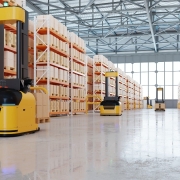Sustainable production through automation
In industries and companies, sustainability refers to the adoption of practices and strategies that allow companies to operate in an economically viable manner, while reducing their environmental impact and improving their responsibility to society and the ecosystem. This may include measures such as reducing greenhouse gas emissions, improving energy efficiency, using renewable energy sources, implementing recycling and reuse practices, and promoting a culture of environmental responsibility among employees.
However, automation not only contributes to improving the efficiency and reducing costs of a company, but also supports caring for the planet since it is a key technology to adopt sustainable practices. Companies can also increase their reputation, reduce their operating costs and attract consumers and investors committed to sustainability. That is why more and more companies are betting more decisively on automation as part of their environmental and sustainability strategies.
Automation can contribute to sustainable production in a number of ways, including:
Less energy consumption
In general, automation can help companies to be more efficient in their energy consumption, which contributes to more sustainable production. For example, in industries automated machines can run for hours without a break, meaning there is no downtime due to breaks, meals, or work shifts. This reduces power consumption compared to systems that require constant stopping and starting.
Similarly, robots and automated machines can be programmed to perform specific tasks with precision, meaning no energy is wasted on unnecessary or poorly performed tasks. This allows companies to carry out a significant optimization of the energy they have consumed.
Predictive Maintenance
Automated machines can be programmed to carry out their own maintenance, which means there is no downtime due to repairs and energy consumption is also optimized in this way.
Monitoring and control
Thanks to the advantages of automation, it is possible to monitor all the electronic components, in such a way that it can be analyzed if any element of the system has an anomaly that affects a loss of efficiency or a greater increase in the usual energy consumption.
Waste control
The current trend in the industry is to be more sustainable in a key aspect and an important component of sustainability, which is the reduction of waste. If companies reduce their waste, the ecological sustainability indices in production increase. At the same time, levels of raw material waste and contamination are reduced, as they can be programmed to perform specific tasks accurately and without error, as discussed above.
Another aspect is quality control, which is much more effective with the automation of production processes and components, since the machines can be equipped with the technology required to perform quality controls in real time, which allows detecting and correcting problems before the waste of raw materials occurs.
As if that were not enough, in the automation of processes and the design of circular products or services they manage to reduce the carbon dioxide emissions of a company, which supposes extraordinary benefits for the care and protection of the layer of ozone. In turn, since they can be programmed to perform specific tasks more efficiently, less raw material is required to perform the same task and helps prevent accidents and guarantee the safety of workers.
Another aspect is the reuse of materials, since automated machines can be used in recycling processes, either to separate and classify materials or to carry out cleaning and preparation tasks for materials for reuse.
How automation contributes to the 2030 Sustainable Development Agenda

The achievement of sustainability in all spheres of society is one of the fundamental challenges of the United Nations Organization (UN), as among its Sustainable Development Goals 2023 (SDG) have clean and non-polluting energy, responsible production and consumption and adopt urgent measures to combat climate change and its harmful effects on life on the planet.
These are the OSDs that automation contributes to on:
SDG 7: Access to affordable and clean energy. As we explained in the first section, automation can help increase energy efficiency in the productive sectors and in companies, which contributes to reducing energy consumption and reducing greenhouse gas emissions.
SDG 9: Industry, innovation and infrastructure. Automation can help improve production efficiency and reduce raw material waste and pollution, contributing to a more sustainable industry.
SDG 12: Responsible consumption and production. The measures adopted within the entity also contribute not only to a more sustainable production, but also to be more responsible with the ecosystem and society.
SDG 8: Decent work and economic growth. Automation can help improve workplace safety by eliminating dangerous tasks and monitoring and controlling the operation of machines, contributing to a safer work environment for workers.
In summary, automation helps companies to be more efficient in the use of their raw materials and to reduce their environmental impact, which encourages more sustainable production.









